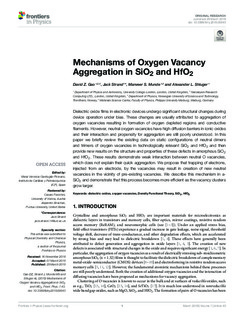| dc.contributor.author | Gao, David Zhe | |
| dc.contributor.author | Strand, Jack | |
| dc.contributor.author | Munde, Manveer S | |
| dc.contributor.author | Shluger, Alexander L | |
| dc.date.accessioned | 2019-09-27T11:55:05Z | |
| dc.date.available | 2019-09-27T11:55:05Z | |
| dc.date.created | 2019-07-25T19:06:25Z | |
| dc.date.issued | 2019 | |
| dc.identifier.citation | Frontiers in Physics. 2019, 7 1-10. | nb_NO |
| dc.identifier.issn | 2296-424X | |
| dc.identifier.uri | http://hdl.handle.net/11250/2619150 | |
| dc.description.abstract | Dielectric oxide films in electronic devices undergo significant structural changes during device operation under bias. These changes are usually attributed to aggregation of oxygen vacancies resulting in formation of oxygen depleted regions and conductive filaments. However, neutral oxygen vacancies have high diffusion barriers in ionic oxides and their interaction and propensity for aggregation are still poorly understood. In this paper we briefly review the existing data on static configurations of neutral dimers and trimers of oxygen vacancies in technologically relevant SiO2 and HfO2 and then provide new results on the structure and properties of these defects in amorphous SiO2 and HfO2. These results demonstrate weak interaction between neutral O vacancies, which does not explain their quick aggregation. We propose that trapping of electrons, injected from an electrode, by the vacancies may result in creation of new neutral vacancies in the vicinity of pre-existing vacancies. We describe this mechanism in a-SiO2 and demonstrate that this process becomes more efficient as the vacancy clusters grow larger. | nb_NO |
| dc.language.iso | eng | nb_NO |
| dc.publisher | Frontiers Media | nb_NO |
| dc.rights | Navngivelse 4.0 Internasjonal | * |
| dc.rights.uri | http://creativecommons.org/licenses/by/4.0/deed.no | * |
| dc.title | Mechanisms of oxygen vacancy aggregation in SiO 2 and HfO 2 | nb_NO |
| dc.type | Journal article | nb_NO |
| dc.type | Peer reviewed | nb_NO |
| dc.description.version | publishedVersion | nb_NO |
| dc.source.pagenumber | 1-10 | nb_NO |
| dc.source.volume | 7 | nb_NO |
| dc.source.journal | Frontiers in Physics | nb_NO |
| dc.identifier.doi | 10.3389/fphy.2019.00043 | |
| dc.identifier.cristin | 1712768 | |
| dc.description.localcode | Copyright © 2019 Gao, Strand, Munde and Shluger. This is an open-a ccess article distributed under the terms of the Creative Commons Attribu tion License (CC BY). The use, distribution or reproduction in other forums is perm itted, provided the original author(s) and the copyright owner(s) are credited a nd that the original publication in this journal is cited, in accordance with acc epted academic practice. No use, distribution or reproduction is permitted which doe s not comply with these terms. | nb_NO |
| cristin.unitcode | 194,66,20,0 | |
| cristin.unitname | Institutt for fysikk | |
| cristin.ispublished | true | |
| cristin.fulltext | original | |
| cristin.qualitycode | 1 | |

